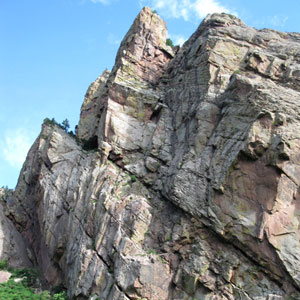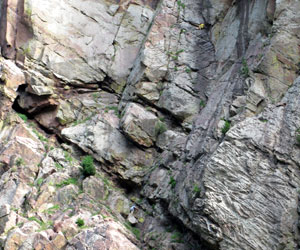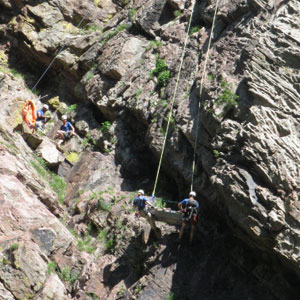






RMRG is a fully
accredited
Mountain Rescue Association (MRA) team
For rescue assistance, call 911 or Boulder County Sheriff's dispatch
(303) 441-4444

Thanks to our supporters:
 Accident Analysis and Rescue Reports
|
On the morning of the June 26th 2010,
Boulder County dispatch notified Rocky Mountain Rescue Group (RMRG) of
an injured climber in need of assistance on
Redgarden Wall in
Eldorado Canyon State Park. The ensuing
rescue took three hours, involved 32 mountain rescue personnel, medical personnel from three agencies,
Boulder County Sherriff Officers, and Colorado State Park personnel.
Events Leading to the Accident[Based on a detailed summary of the accident written by Bill Wright, one of the climbers. RMRG sincerely appreciates Bill Wright's public support. However, other than receiving rescue services, he is not affiliated with RMRG. His words and opinions are his own. ] Redgarden Wall from the south east, Click to enlarge
Redgarden Wall from the south east, Click to enlarge
The RescueThe following is an account of the rescue that took place after the fall. This is not an analysis of the cause of the accident.Initial ResponseAt 7:27 am a request for assistance went out to RMRG, Rocky Mountain Fire, Boulder County Emergency Services, and Eldorado Canyon State Park. Initial dispatch information included a preliminary description of the accident and injuries (fallen climber, unconscious), a likely location (Redgarden Wall), and crucially, that the injured climber was hundreds of feet off the ground, dangling from a rope. A Boulder County Sheriff's Officer, also an active climber, arrived at the park minutes after the initial page; he was able to gather information from witnesses and assess the accident site from the road. He determined that the climbers were on the Redgarden wall to the right of The Naked Edge. Climber locations, Click to enlarge
Climber locations, Click to enlarge
Patient AccessA rescue of an injured party in vertical terrain usually requires a significant amount of equipment. In general, it is easier to move this gear over 3rd and 4th class terrain than it is over 5th class terrain. Therefore, RMRG typically sends rescuers and equipment in from the top of the cliff, via the "walk-off" trail, rather than haul the equipment up to the patient through 5th class terrain. There are some cases, however, when the access from above is more complicated and hauling from below becomes safer and more efficient (see Doub Griffith rescue). In this case, given the uncertainty of the number of injured climbers and their exact locations, RMRG began deploying rescuers to the top of the Redgarden Wall via the East Slabs descent route while further analysis of the situation could be done. The first RMRG member arrived at the State Park at 7:35 am and began fixing lines at the "Chock Stone," a vertical rock constriction at the access point to the East Slabs. Fixing lines up the Chock Stone and East Slabs allows rescuers carrying heavy equipment to ascend more quickly, safely, and efficiently. At approximately 7:45 am, further fire department and RMRG rescue vehicles arrived at the park and began assembling the necessary personnel and rescue equipment for insertion via the East Slabs. Additional rescuers and ropes were expedited to continue fixing lines up the East Slabs in preparation for the evacuation equipment and personnel to follow. Two rescuers soloed the East Slabs to begin assessing anchors and evacuation lines at the top of the wall. Spotters were positioned across the canyon to evaluate whether rescuers would be able access the climbers more quickly from below, to determine whether it was viable to haul evacuation gear up from below, as well as identify options for evacuation routes that could be taken down the face of Redgarden Wall. An RMRG member interviewed witnesses and established that the lower climber was definitely injured. However, the status of the upper climber was still unknown. Given this, it was decided that the first RMRG medical personnel would access the lower climber from below by climbing the route Touch and Go. Shortly thereafter, however, a pair of climbers on the Naked Edge rappelled to the bolt anchors at the top of Touch and Go and lowered a fixed line for rescuers to ascend. This selfless act for their fellow climbers in need saved significant time in getting medical care to the patient. An RMRG paramedic quickly ascended this fixed line and was treating the injured climber by 8:43 am. An RMRG doctor followed the paramedic and advanced medical care was provided throughout the remainder of the rescue. Two more RMRG members ascended the lines and hauled medical and technical gear to the ledge and established a crucial rock-protection anchor and mechanical advantage system that would allow rescuers to raise and lower the injured climber into the rescue litter once it arrived on scene. Rescuers securing and caring for the injured climber,
Rescuers securing and caring for the injured climber, Photo © Alison Sheets, 2010. Click to enlarge Evacuation Rescuers manuevering the litter and patient down the wall
Rescuers manuevering the litter and patient down the wallClick to enlarge  Rescuers evacuating the litter and patient using scree evacuation technique. Click to enlarge
Rescuers evacuating the litter and patient using scree evacuation technique. Click to enlarge
ConclusionThe extensive climbers' account referenced above provides significant information on the events leading up to the accident. One clear lesson can be drawn immediately: From the extent of damage to the injured climber's helmet, there is little doubt that its use prevented more significant injuries. Also, proper help from fellow climbers on scene in the early stages of an accident can prove invaluable to the effectiveness of a subsequent rescue. The climbers on the nearby route that lowered and fixed their climbing ropes for ascent by RMRG members increased the speed of getting advanced medical personnel to the injured climber. Additionally, the added risks of the simul-climbing technique must be fully understood before it is employed. In this case the climbers had an awareness of the restrictions this technique imposed and were able to improvise self and companion rescue techniques. While most often not being able to replace organized rescue response, self and companion rescue can stabilize a situation while the larger rescue is getting underway. The actions in the early stages of this accident of the climbing partner served to stabilize both himself and his injured partner to the extent possible while awaiting rescue.AcknowledgementsRMRG wishes to thank all the individuals and agencies involved in this rescue. In addition to 25 RMRG members, seven rescuers from Alpine Rescue Team (Evergreen, CO), personnel from Rocky Mountain Fire, AMR, Louisville Fire, Boulder County Sheriffs Office, Colorado State Parks, and Air Life assisted in this rescue. Furthermore, many thanks must go to the climbers who assisted this rescue by allowing their climbing rope to be used as a fixed line, ultimately providing faster access for medical care. For additional information on climbing rescue response in Eldorado Canyon or the evacuation techniques used, see the FAQ web page. For any other questions please contact us. |
| This page is superseded | Visit our current web site at |
http://RockyMountainRescue.org |
Rocky Mountain Rescue Group, Inc. 3720 Walnut St, Boulder, CO 80301, USA |
Copyright 2017, Rocky Mountain Rescue Group, Inc. |






